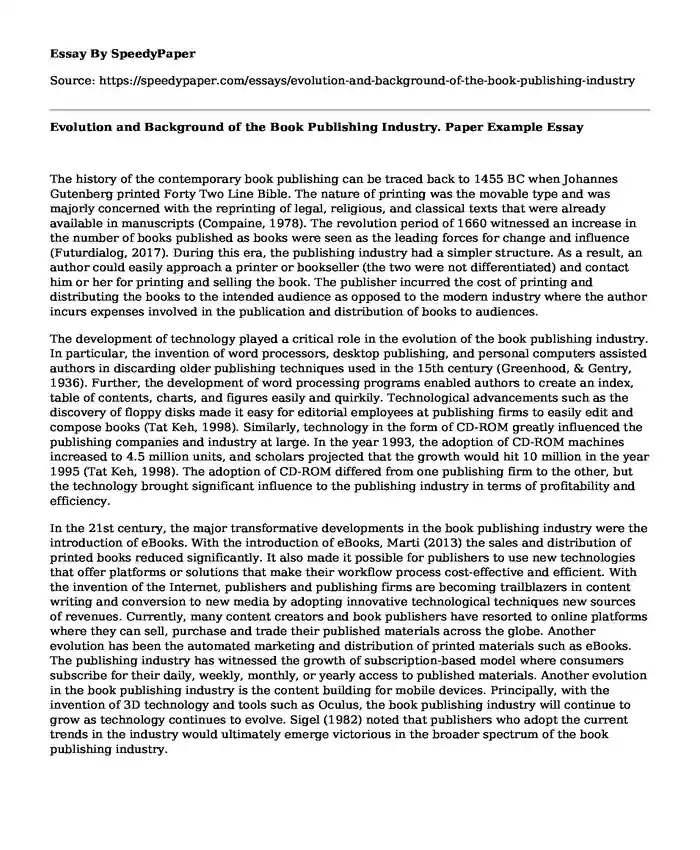
| Type of paper: | Report |
| Categories: | History Social networks Internet Books |
| Pages: | 3 |
| Wordcount: | 638 words |
The history of the contemporary book publishing can be traced back to 1455 BC when Johannes Gutenberg printed Forty Two Line Bible. The nature of printing was the movable type and was majorly concerned with the reprinting of legal, religious, and classical texts that were already available in manuscripts (Compaine, 1978). The revolution period of 1660 witnessed an increase in the number of books published as books were seen as the leading forces for change and influence (Futurdialog, 2017). During this era, the publishing industry had a simpler structure. As a result, an author could easily approach a printer or bookseller (the two were not differentiated) and contact him or her for printing and selling the book. The publisher incurred the cost of printing and distributing the books to the intended audience as opposed to the modern industry where the author incurs expenses involved in the publication and distribution of books to audiences.
The development of technology played a critical role in the evolution of the book publishing industry. In particular, the invention of word processors, desktop publishing, and personal computers assisted authors in discarding older publishing techniques used in the 15th century (Greenhood, & Gentry, 1936). Further, the development of word processing programs enabled authors to create an index, table of contents, charts, and figures easily and quirkily. Technological advancements such as the discovery of floppy disks made it easy for editorial employees at publishing firms to easily edit and compose books (Tat Keh, 1998). Similarly, technology in the form of CD-ROM greatly influenced the publishing companies and industry at large. In the year 1993, the adoption of CD-ROM machines increased to 4.5 million units, and scholars projected that the growth would hit 10 million in the year 1995 (Tat Keh, 1998). The adoption of CD-ROM differed from one publishing firm to the other, but the technology brought significant influence to the publishing industry in terms of profitability and efficiency.
In the 21st century, the major transformative developments in the book publishing industry were the introduction of eBooks. With the introduction of eBooks, Marti (2013) the sales and distribution of printed books reduced significantly. It also made it possible for publishers to use new technologies that offer platforms or solutions that make their workflow process cost-effective and efficient. With the invention of the Internet, publishers and publishing firms are becoming trailblazers in content writing and conversion to new media by adopting innovative technological techniques new sources of revenues. Currently, many content creators and book publishers have resorted to online platforms where they can sell, purchase and trade their published materials across the globe. Another evolution has been the automated marketing and distribution of printed materials such as eBooks. The publishing industry has witnessed the growth of subscription-based model where consumers subscribe for their daily, weekly, monthly, or yearly access to published materials. Another evolution in the book publishing industry is the content building for mobile devices. Principally, with the invention of 3D technology and tools such as Oculus, the book publishing industry will continue to grow as technology continues to evolve. Sigel (1982) noted that publishers who adopt the current trends in the industry would ultimately emerge victorious in the broader spectrum of the book publishing industry.
References
Compaine, B. M. (1978). The Book Industry in Transition: An Economic Analysis of Book Distribution and Marketing. White Plains, NY: Knowledge Industry Publications.
Futurdialog. (2017, April 24). The Evolution of Content in the Publishing Industry. Retrieved April 10, 2019, from http://futurdialog.com/index.php/2017/04/24/the-evolution-of-content-in-the-publishing-industry/
Greenhood, D., & Gentry, H. (1936), Chronology of Books and Printing. Macmillan: New York, NY
Marti, D. (2013, June 25). E-books and the evolution of the publishing industry. Retrieved April 10, 2019, from https://www.gbnews.ch/e-books-and-the-evolution-of-the-publishing-industry/
Sigel, E. (1982). The future of the book, in Books, Libraries, and Electronics, Knowledge Industry Publications. White Plains, NY, p. 31
Tat Keh, H. (1998). Evolution of the book publishing industry: Structural changes and strategic implications. Journal of management history, 4(2), 104-123.
Cite this page
Evolution and Background of the Book Publishing Industry. Paper Example. (2022, Dec 26). Retrieved from https://speedypaper.net/essays/evolution-and-background-of-the-book-publishing-industry
Request Removal
If you are the original author of this essay and no longer wish to have it published on the SpeedyPaper website, please click below to request its removal:
- Why People Buy Stuff, Free Essay for You
- Allegory Writing Essay Example
- Amiri Baraka Conversion to Islam and Influence of Other Ideologies, Poetry Essay Example
- New Jerusalem by William Blake, Free Essay with Poem Analysis
- Free Essay Describing the Community Development Project Analysis: Men's Shed
- Essay Sample on Martin Luther King Jr's Letter from Birmingham Jail
- Paper Example: Financial Statement Audit
Popular categories




